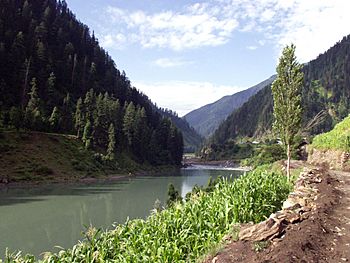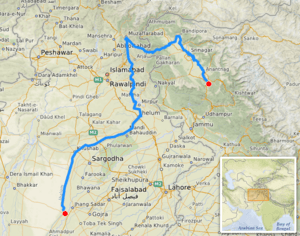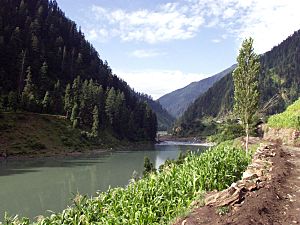Jhelum River facts for kids
Quick facts for kids Jhelum |
|
|---|---|

Jhelum River photographed in Pakistan, c. 2006
|
|

Map showing the Jhelum's watercourse [1].
|
|
| Native name |
|
| Other name(s) | Hydaspes, Bidaspes, Vitastā, Bihat, Wihat, Bihatab, Biyatta, Jailam |
| Countries | |
| Physical characteristics | |
| Main source | Verinag Spring |
| River mouth | Chenab River |
| Length | 725 km (450 mi) |
| Discharge (location 2) |
(near Baramulla) |
| Basin features | |
| River system | Indus River |
| Tributaries |
|
The Jhelum River is an important river that flows through northwestern India and eastern Pakistan. It is the most western of the five rivers in the Punjab area. This river flows through the Srinagar District and is about 725 kilometres (450 mi) long. The Jhelum River eventually joins the mighty Indus River.
Contents
Lakes Along the Jhelum
The Jhelum River is connected to several beautiful lakes. These lakes are important parts of the river's journey.
- Wular Lake
- Dal Lake
- Manasbal Lake
- Gangabal Lake
- Nigeen Lake
- Anchar Lake
Dams and Barrages on the Jhelum
The Jhelum River is very important for making electricity in India. Many structures have been built on the river to control its water. These projects are part of the Indus Basin Project.
Here are some of the main dams and barrages:
- Mangla Dam: This dam was finished in 1967. It is one of the biggest earth-filled dams in the world. It can hold a huge amount of water, about 5,900,000 acre-feet (7.3 km3).
- Rasul Barrage: Built in 1967, this barrage can handle a very large flow of water, up to 24,000 cubic meters per second.
- Trimmu Barrage: This barrage was built in 1939. It is located about 20 km from Jhang Sadar, where the Jhelum meets the Chenab River. It can discharge up to 18,000 cubic meters of water per second.
- Haranpur (Victoria Bridge): This bridge was built in 1933. It is about 5 km from Malakwal. The bridge is 1 km long and is mainly used by Pakistan Railways. There is also a path for light vehicles, motorcycles, bicycles, and people walking.
- Uri Dam: This dam has a hydroelectric power station that can produce 480 megawatts of electricity. It is located in the Jammu and Kashmir state.
- Kishanganga Hydroelectric Plant: This power plant can produce 330 megawatts of electricity. It is also located in the Jammu and Kashmir state.
Canals Connected to the Jhelum
Canals are like man-made rivers that help move water from one place to another. The Jhelum River is connected to several important canals:
- Upper Jhelum Canal: This canal starts at the Mangla Dam and carries water to the Chenab River.
- Rasul-Qadirabad Link Canal: This canal connects the Rasul Barrage to the Chenab River.
- Chashma-Jhelum Link Canal: This canal brings water from the Chashma Barrage on the Indus River to the Jhelum River. It is about 40 kilometres (25 mi) long.
Images for kids
-
Rope Bridge at Karli, 1908
-
Bridge over the river, Srinagar, 1969
-
Jhelum river near Muzaffarabad (2014)
-
Jhelum River at Jhelum City, 2005
See also
 In Spanish: Río Jhelum para niños
In Spanish: Río Jhelum para niños













